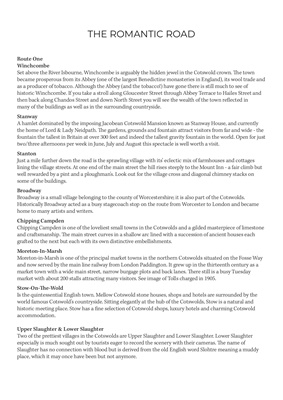
THE ROMANTIC ROAD
Route One
Winchcombe
Set above the River Isbourne, Winchcombe is arguably the hidden jewel in the Cotswold crown.
The town became prosperous from its Abbey (one of the largest Benedictine monasteries in England), its wool
trade and as a producer of tobacco. Although the Abbey (and the tobacco!) have gone there is still much to see
of historic Winchcombe. If you take a stroll along Gloucester Street through Abbey Terrace to Hailes Street
and then back along Chandos Street and down North Street you will see the wealth of the town reflected in
many of the buildings as well as in the surrounding countryside.
Stanway
A hamlet dominated by the imposing Jacobean Cotswold Mansion known as Stanway House, and currently
the home of Lord & Lady Neidpath. The gardens, grounds and fountain attract visitors from far and wide - the
fountain the tallest in Britain at over 300 feet and indeed the tallest gravity fountain in the world. Open for just
two/three afternoons per week in June, July and August this spectacle is well worth a visit.
Stanton
Just a mile further down the road is the sprawling village with its' eclectic mix of farmhouses and cottages
lining the village streets. At one end of the main street the hill rises steeply to the Mount Inn - a fair climb but
well rewarded by a pint and a ploughman's. Look out for the village cross and diagonal chimney stacks on
some of the buildings.
Broadway
Broadway is a small village belonging to the county of Worcestershire; it is also part of the Cotswolds.
Historically Broadway acted as a busy stagecoach stop on the route from Worcester to London and became
home to many artists and writers.
Chipping Campden
Chipping Campden is one of the loveliest small towns in the Cotswolds and a gilded masterpiece of limestone
and craftsmanship. The main street curves in a shallow arc lined with a succession of ancient houses each
grafted to the next but each with its own distinctive embellishments.
Moreton-In-Marsh
Moreton-in-Marsh is one of the principal market towns in the northern Cotswolds situated on the Fosse Way
and now served by the main line railway from London Paddington. It grew up in the thirteenth century as a
market town with a wide main street, narrow burgage plots and back lanes. There still is a busy Tuesday
market with about 200 stalls attracting many visitors. See image of Tolls charged in 1905.
Stow-On-The-Wold
Is the quintessential English town. Mellow Cotswold stone houses, shops and hotels are surrounded by the
world famous Cotswold's countryside. Sitting elegantly at the hub of the Cotswolds, Stow is a natural and
historic meeting place. Stow has a fine selection of Cotswold shops, luxury hotels and charming Cotswold
accommodation.
Upper Slaughter & Lower Slaughter
Two of the prettiest villages in the Cotswolds are Upper Slaughter and Lower Slaughter. Lower Slaughter
especially is much sought out by tourists eager to record the scenery with their cameras. The name of
Slaughter has no connection with blood but is derived from the old English word Slohtre meaning a muddy
place, which it may once have been but not anymore.